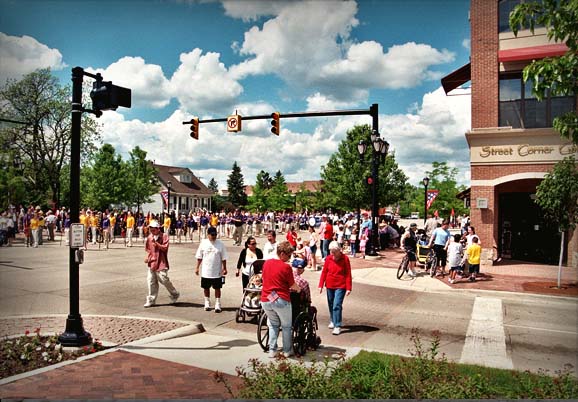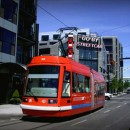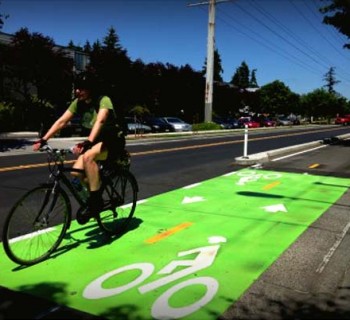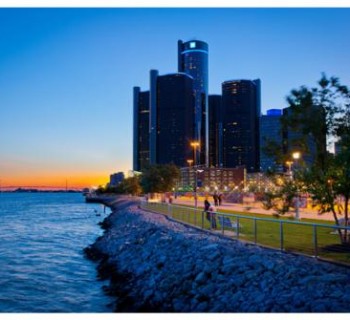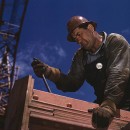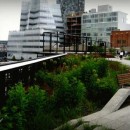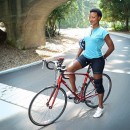AUBURN HILLS, Mich.—Drive east along Auburn Road into town and watch the scenery change from a long series of shopping plazas, drive-up banks and massive gas stations to a symphony of sights. There’s old fashioned street lights, brick-paved sidewalks, painted bike lanes, park benches, river trails and rows of multi-story buildings set out like a long-time downtown.
Wait a minute. Many of the buildings have been erected in the last three years.

“Auburn Hills – a 30 year old city – had become too large, too spread out. People told us they wanted a sense of place where people could walk, shop, eat, even fish by the river,” said Pete Auger, city manager, who spearheaded the drive for a downtown in a 17-square-mile community known for gleaming glass office buildings and giant subdivisions.
“You get close to Riverside Park and you can’t find a parking spot. People are walking about, eating sandwiches and pizza they bought nearby and talking to one another. I saw one guy with his shirtsleeves rolled up, looking at the river, Skyping a friend in Australia.”
Come summer the town plans a weekly farmer’s market, Summerfest, Paddlepalooza and a concert series. All year long businesses and restaurants open their doors to passing pedestrians. Among owners, the people owning the Pampered Pooch, dog grooming business, moved from a home-based business to downtown two years ago to be part of the vitality.
Students play a huge role in density. City officials recently opened a renovated log cabin called “The DEN,” a 1,546 square-foot space with two fireplaces and five rooms where students and community members can gather for quiet and casual study space.
The building opened in mid-January along with University Center, an all new set of classrooms in a downtown building set for use by the five local colleges and Oakland University. State of the art technology offers transmission links to the campuses or anywhere in the world.
Auger said he is most proud of the buildings that have gone up since 2011. This includes a combination of two-, three- and four-story buildings, includes a 233-space parking structure and 97 apartments in Auburn Square. A condominium project is in the works. He credits help from the Ann Arbor-based Michigan Municipal League, among other resources.
“Pete Auger was part of an effort we started several years ago to bring our member communities up to speed about what it takes to be a vibrant community in the 21st century. The top asset is walkability,” said Arnold Weinfeld, director of strategic initiatives for the League.
Auburn Hills, according to Weinfield, is one of the first cities in Michigan to create a downtown, to connect the dots between existing stores and an abundance of new buildings. “They had the advantage of tax increment financing and available land,” Weinfeld added.
Plans and infrastructure for an enhanced downtown started in 1998. Auburn Hills city leaders issued a comprehensive plan to the community for connecting the storefronts along Auburn at Squirrel roads and building places where the public could gather. They felt it couldn’t be a Birmingham or Royal Oak due it’s size, recalls Steve Cohen, director of Community Development, but it they decided to work to could liven up the existing street with its assorted bowling alley, bar, restaurant and other retailers to create a “heart” for the city.
Between 2001 and 2002, the city spent $11 million to improve the roads with bike lanes, brick paved crosswalks, old time streetlights, trees, and park benches. In 2001 they spent $1.8 million to convert the rail spur along the Clinton River to a bike/walk path. In 2005 they erected an inline skate and skateboard park for young residents.
Then bigger plans began to happen, a number of private development projects started to go up. Then in 2009, the city developed and adopted a new marketing strategy that targeted the needs of the young working talent and college students within Auburn Hills. The millenneals told the city they want a walkable community along with the suburban amenities.
To be sure, Auburn Hills, which started life as Pontiac Township, is known for its 22 high-technology parks. Eighty percent of its tax base is commercial and industrial, one of the highest business mixes in Oakland County.
Home to more than 21,000 residents, the community also serves as Michigan’s global business address, with 40 international corporations from 32 countries housed there, including Chrysler Group LLC and Borg Warner headquarters. Additionally, the city has five colleges and universities, the Palace of Auburn Hills for entertainment and Great Lakes Crossing Outlets, one of the newest shopping centers in southeast Michigan.
Laurie Renaud, coordinator of business development for Auburn Hills, said city officials held series of meetings with stakeholders, both residents, workers and corporate executives. What did they want to see in a more cohesive town?
“These new developments would not have been possible without the hard work, collaboration and dedication of the city’s development team, as well as the architects, construction managers, interior designers, owners and renovation/restoration teams that made each project come to life,” said Tom Tanghe, assistant city manager and executive director of the tax increment financing authority.

With one of the most stable tax bases in southeast Michigan, Auburn Hills could realistically capture the growth in tax revenue in three separate and distinct development districts and establish priorities for use. Renaud said officials assembled a budget of $20 million to build off-campus classrooms and plazas.
What’s next? Auger would love to see the DEN turned into a 24-hour study center with round the clock monitoring where students from any college could study and meet in small groups with Wi-Fi access. The city is planning an amphitheater and more enhancements to the Clinton River Trail which runs through the downtown.
In the meantime, retrofitting suburbs is becoming a hot topic nationally. Recently Ellen Dunham-Jones gave a TED talk on the topic. Numerous places around the country are looking at ways to bring a sense of place and people together.
“We’re proud of our city and our downtown and thrilled to tell our story,” Auger said. He is half way through a five-year plan now.
Watch out cyclists, strollers and park bench spectators, the best is yet to come.


